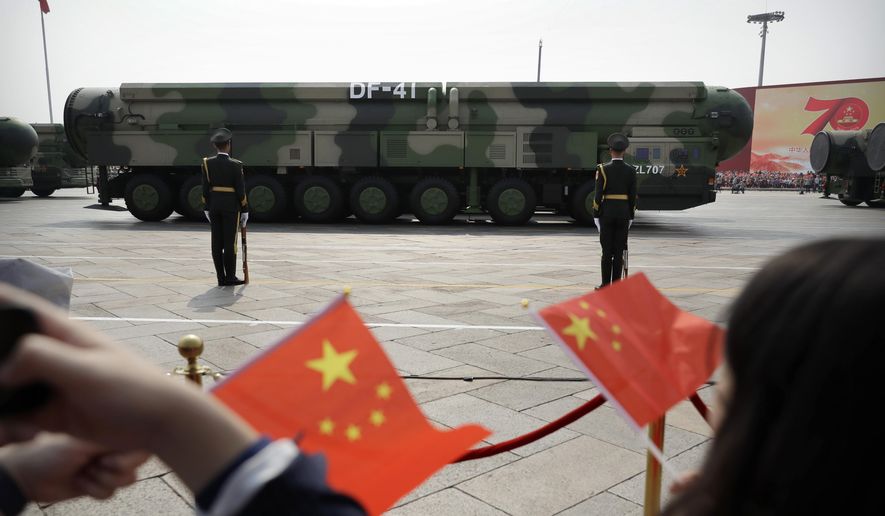A version of this story appeared in the daily Threat Status newsletter from The Washington Times. Click here to receive Threat Status delivered directly to your inbox each weekday.
Under pressure from Congress, the Pentagon on Wednesday released an updated and expanded list of nearly 50 Chinese military companies currently operating in the United States. The list includes several key weapons makers such as the Aviation Industry Corp. of China Ltd. and China Aerospace Science and Industry Corp. Ltd.
Two state-run nuclear companies on the list — the China National Nuclear Corp. and China General Nuclear Power Group — are key players in China’s rapid nuclear weapons buildup and have been sanctioned by the Treasury Department in the past for suspected diversion of civilian nuclear technology to the Chinese military.
The 46 companies, including 17 subsidiaries is a marked increase since the first list was published in 2021. That list included 34 companies and 13 subsidiary companies. Thirteen companies were added to the list in 2022.
The inclusion of IDG Capital Partners Co., Ltd., indicates U.S. officials believe the prominent venture capital firm is also helping fund Chinese military development.
Publication of the list was required under legislation passed in 2021. The list was made public a day after seven Republican senators wrote to Defense Secretary Lloyd Austin demanding its release.
Congress passed the requirement for the list with bipartisan support “to highlight and counter the People’s Republic of China’s Military-Civil Fusion strategy, which supports the modernization goals of the People’s Liberation Army,” the lawmakers wrote to Mr. Austin.
Other prominent military-related firms on the latest list include China Aerospace Science and Industry Corp. Ltd., (CASIC), China’s main manufacturing of ballistic and cruise missiles; the China State Shipbuilding Corp. Ltd., a major warship builder; China North Industries Group Corp. Ltd., which was linked in 1996 to the illegal importation of 2,000 Chinese-made AK-47 automatic rifles; and Chinese high-tech superstar Huawei Technologies, the controversial telecommunications company.
China launched its military-civil fusion program in 2017 with a central commission to coordinate military and civilian development. The program is designed to funnel civilian technology into China’s military buildup. Critics say it is also stealing key technologies from American and other foreign sources.
“In a secretive and exploitative manner, China is acquiring the intellectual property, key research, and technological advancements of the world’s citizens, researchers, scholars, and private industry in order to advance its military aims,” says the letter, which was signed by Republican Sens. Ted Budd of North Carolina, Tom Cotton of Arkansas, Rick Scott of Florida, Tommy Tuberville of Alabama, Joni Ernst of Iowa, Deb Fischer of Nebraska and Kevin Cramer of North Dakota.
The senators said it was imperative for the Pentagon to make the list public to “ensure that U.S. and international companies are aware of specific Chinese entities that are supporting China’s military ambitions.”
The State Department, in a 2020 fact sheet, stated that China’s military-civil fusion program is “an aggressive, national strategy of the Chinese Communist Party (CCP).”
The goal: to turn the People’s Liberation Army into a world-class military by 2049. Chinese President Xi Jinping “personally oversees the strategy’s implementation,” the State Department said at the time.
Key focus areas include artificial intelligence (AI) for producing the next revolution in military affairs. China believes the first nation to adapt AI for next-generation warfare will achieve military dominance. In addition to AI, key technologies for the Chinese include quantum computing, “big data” analysis, semiconductors, 5G, advanced nuclear technology, and aerospace technology.
“In a clandestine and non-transparent manner, [China] is acquiring the intellectual property, key research, and technological advancements of the world’s citizens, researchers, scholars, and private industry in order to advance military aims,” the report said. “Joint research institutions, academia, and private firms are all being exploited to build the PLA’s future military systems — often without their knowledge or consent.”
• Bill Gertz can be reached at bgertz@washingtontimes.com.




Please read our comment policy before commenting.